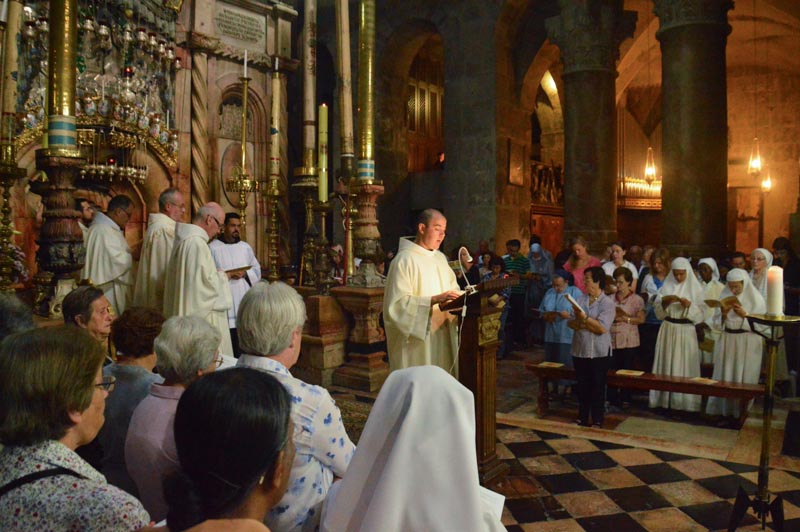
Every fifteenth of July the Diocese of Jerusalem commemorates the day that the Crusaders’ Basilica of the Holy Sepulchre was consecrated as a religious building. In the same way as the Church joins together every November 9th to celebrate the Dedication of the Lateran Basilica, all the parishes and Catholic communities present in the Holy Land celebrate the Dedication of the Holy Sepulchre. As mass is sung daily by the Franciscans in front of Christ’s tomb in the small hours of the morning, the Latin Church of Jerusalem joined the conventual community to celebrate this anniversary.
The dedication goes back to the year 1149, when the Crusaders consecrated the altar and sprinkled holy water in the newly rebuilt basilica. As Fra Stéphane reminds us, “We are not celebrating the glory of the Crusades. When the Franciscans came here in the 14th century and began to serve in the Holy Sepulchre, they were inserted into the country with their own values and ways of behaving: respect for others, dialogue and perseverance. This dedication recalls the primary purpose of the basilica—celebrating worship, a worship to which all the Christians in the world are invited.”
The Custos of the Holy Land being on a pastoral visit to Syria and Cyprus at the moment, the Custodial Vicar, Fra Dobromir Jasztal, officiated for the celebration. In his homily, Fra Dobromir recalled that over the centuries there have been several dedications. Orthodox Christians commemorate, for example, the dedication of the Byzantine basilica by Constantine on September 14th. “Several dedications, several basilicas, but only one tomb and one mystery; that is the essence,” he declared. Pilgrim or parishioner, everyone who prays at the Holy Sepulchre becomes a “witness of the Resurrection,” he concluded.
This mystery of the Lord is celebrated every day in the Holy Sepulchre in different languages and according to different rites, as defined in the Status Quo of 1842. The worship is sometimes “inconvenient” or at least surprising to the crowd of impatient pilgrims waiting to enter the tomb who quickly move to one or another of the chapels or simply remain in place in pious silence. This Dedication of the Holy Sepulchre reminds us that public worship takes priority over the private desires of individuals: a precious time of encounter in the place where God renewed his covenant with his people.
E.R.
The dedication goes back to the year 1149, when the Crusaders consecrated the altar and sprinkled holy water in the newly rebuilt basilica. As Fra Stéphane reminds us, “We are not celebrating the glory of the Crusades. When the Franciscans came here in the 14th century and began to serve in the Holy Sepulchre, they were inserted into the country with their own values and ways of behaving: respect for others, dialogue and perseverance. This dedication recalls the primary purpose of the basilica—celebrating worship, a worship to which all the Christians in the world are invited.”
The Custos of the Holy Land being on a pastoral visit to Syria and Cyprus at the moment, the Custodial Vicar, Fra Dobromir Jasztal, officiated for the celebration. In his homily, Fra Dobromir recalled that over the centuries there have been several dedications. Orthodox Christians commemorate, for example, the dedication of the Byzantine basilica by Constantine on September 14th. “Several dedications, several basilicas, but only one tomb and one mystery; that is the essence,” he declared. Pilgrim or parishioner, everyone who prays at the Holy Sepulchre becomes a “witness of the Resurrection,” he concluded.
This mystery of the Lord is celebrated every day in the Holy Sepulchre in different languages and according to different rites, as defined in the Status Quo of 1842. The worship is sometimes “inconvenient” or at least surprising to the crowd of impatient pilgrims waiting to enter the tomb who quickly move to one or another of the chapels or simply remain in place in pious silence. This Dedication of the Holy Sepulchre reminds us that public worship takes priority over the private desires of individuals: a precious time of encounter in the place where God renewed his covenant with his people.
E.R.

